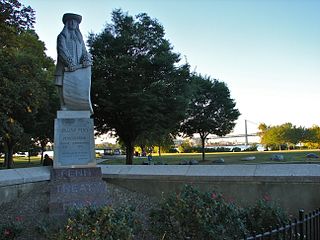
Fishtown is a neighborhood in the River Wards section of Philadelphia, Pennsylvania, United States. Located northeast of Center City Philadelphia, its borders are somewhat disputed today due to many factors, but are roughly defined by the triangle created by the Delaware River, Front Street, and York Street. Some newer residents expand the area to Lehigh Avenue to the northeast, while some older residents shrink the area to Norris Street. It is served by the Market–Frankford Line rapid transit subway/elevated line of the SEPTA system. Fishtown is a largely working class Irish Catholic neighborhood, but has recently seen a large influx of young urban professionals and gentrification.

Manayunk is a neighborhood in the section of Lower Northwest Philadelphia in the state of Pennsylvania. Located adjacent to the neighborhoods of Roxborough and Wissahickon and also on the banks of the Schuylkill River, Manayunk contains the first canal begun in the United States.

Northern Liberties is a neighborhood in Philadelphia, Pennsylvania, United States. It is north of Center City along the Delaware River. Prior to its incorporation into Philadelphia in 1854, it was among the top 10 largest cities in the U.S. in every census from 1790 to 1850. It was a major manufacturing area that attracted many European immigrants in the late 19th and early 20th centuries. In the early 21st century, it has attracted many young professionals and new commercial and residential development

Kensington is a neighborhood in Philadelphia that belongs to Lower Northeast. As with all neighborhoods in the city, the lack of any official designation means the boundaries of the area vary between sources over time and are disputed among locals. Kensington, as most long-term residents view it, refers generally to the area consisting of Kensington, East Kensington, West Kensington, and Harrowgate. The adjacent Fairhill and Norris Square neighborhoods are more separate but may be included in Kensington; Fishtown and South (Olde) Kensington were historically included. The most conservative boundaries of the neighborhood, shown in the map below, are Front Street and 5th Street to the west, the Amtrak train tracks to the North, Trenton Avenue, the Trenton Avenue train tracks, and Frankford Avenue to the east, and Cecil B. Moore Avenue to the south.

Hartford is one of five unincorporated villages in the town of Hartford, Windsor County, Vermont, United States. It is also referred to as Hartford Village. For the 2020 census it was listed as a census-designated place, with a population of 754, out of 10,686 in the entire town of Hartford.
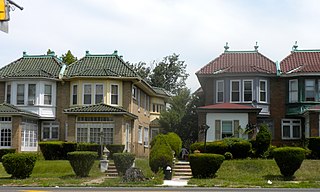
Cobbs Creek is a neighborhood located in the West Philadelphia section of Philadelphia, Pennsylvania, United States, named for the creek which forms part of Philadelphia's western border. Cobbs Creek is generally bounded by Market Street to the north, Baltimore Avenue to the south, 52nd Street to the east, and the border of Upper Darby along Cobbs Creek to the West.
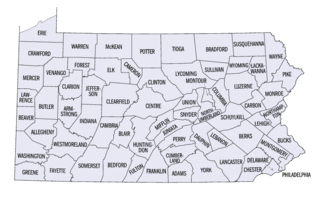
This is a list of properties and districts listed on the National Register of Historic Places in Pennsylvania. As of 2015, there are over 3,000 listed sites in Pennsylvania. All 67 counties in Pennsylvania have listings on the National Register.
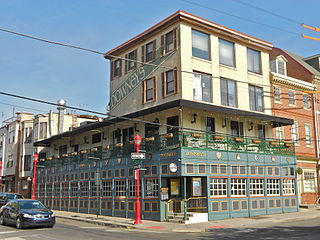
Front Street in Philadelphia, Pennsylvania is a north–south street running parallel to and near the Delaware River. In 1682, when the city was laid out by William Penn, it was the first street surveyed and built in during the colonial era Province of Pennsylvania. As part of the King's Highway, which extended from Boston to Charleston, South Carolina, and as the waterfront of Philadelphia's port, it was the most important street in the city from its founding into the 19th century.
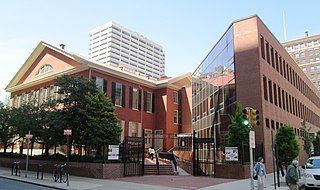
The Race Street Meetinghouse is an historic and still active Quaker meetinghouse at 1515 Cherry Street in the Center City area of Philadelphia, Pennsylvania. The meetinghouse served as the site of the Yearly Meeting of the Hicksite sect of the Religious Society of Friends (Quakers) from 1857 to 1955.

The Heywood-Wakefield Company Complex is a historic factory complex at 206 Central Street in Gardner, Massachusetts. The complex, located at the corner of Central and Elm in West Gardner, has its origins in a chair manufacturing business established in 1826 by the Heywood brothers. The current brick factory buildings date to the later decades of the 19th century. The property was listed on the National Register of Historic Places in 1983.

The West Gardner Square Historic District encompasses the historic commercial, civic and industrial downtown area of Gardner, Massachusetts. Developed industrially beginning in the early 19th century, the area now boasts a concentration of late 19th and early 20th century commercial, civic, and industrial architecture. It was listed on the National Register of Historic Places in 1985.

The Levi Heywood Memorial Library Building is an historic library building at 28 Pearl Street in Gardner, Massachusetts. Completed in 1886, it is one of the city's most architecturally distinguished buildings, and a good example of Richardsonian Romanesque design. It was given in honor of Levi Heywood, a prominent figure in the city's economically important chair manufacturing industry. It was used as a library until 1978, and now houses a museum dedicated to the city's history. The building was listed on the National Register of Historic Places in 1979, and included in the Gardner Uptown Historic District in 1999.

This is a list of the National Register of Historic Places listings in Center City, Philadelphia.

The Wakefield Rattan Company was the world's leading manufacturer of rattan furniture and objects in the second half of the 19th century. Founded by Cyrus Wakefield in 1851 in South Reading, Massachusetts, it perfected machinery for working with rattan, developing looms for weaving chair seats and mats. Its products also included wicker furniture and baby carriages. The company also successfully found uses for previously wasted portions of the plant, using shavings to create baling fabric and floor coverings. Its products were available throughout the United States.

The Northville Historic District is located in Northville, Michigan. It was designated a Michigan State Historic Site in 1970 and listed on the National Register of Historic Places in 1972. The district is roughly bounded by Cady Street, Rogers Street, and Randolph Street; alterations to the boundaries of the city-designated district in 2003 and 2007 included structures on the opposite sides of the original bounding streets within the district. The district is located in the heart of old Northville, and is primarily residential, although the 73 contributing structures, include several commercial buildings and a church. The majority of the district contains Gothic Revival houses constructed between 1860 and 1880.

Willis Gaylord Hale was a late-19th century architect who worked primarily in Philadelphia, Pennsylvania. His flamboyant, highly-ornate style was popular in the 1880s and 1890s, but quickly fell out of fashion at the dawn of the 20th century.
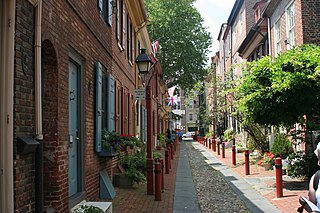
Elfreth's Alley is a historic street in the Old City neighborhood of Philadelphia, Pennsylvania, dating to 1703. The street has 32 houses, built between 1703 and 1836. The Elfreth's Alley Museum is located at #124 and 126.

The Broad Street Historic District is a historic district in Center City, Philadelphia, Pennsylvania, United States. It is bounded roughly by Juniper, Cherry, 15th, and Pine Streets, covering an area about one block on either side of Broad Street.

The General Electric Switchgear Plant is a historic factory building located at 421 North 7th Street at Willow Street in the Callowhill neighborhood of Philadelphia, Pennsylvania. It was built in 1916, and is a seven-story, seven bay by nine bay, reinforced concrete building with brick facing. It was designed by William Steele & Company for General Electric, which manufactured electric switchboard equipment there.
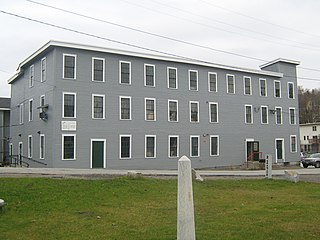
The National Clothespin Factory is a historic industrial building at One Granite Street in Montpelier, Vermont. Built in 1918, it is a significant local example of an early 20th-century wood-frame factory, and was home to the nation's last manufacturer of wooden clothespins. Now adapted for other uses, the building was listed on the National Register of Historic Places in 2005.

























